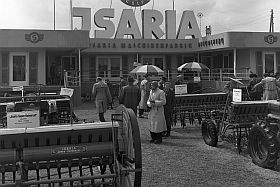From a manufacturer of agricultural machinery to an automobil producer Back in 1860, Maurus Glas founded the first agricultural machinery factory in the district town of Freising, in Bavaria. He employed up to 300 workers and their machines sold very well. His son, Andreas after traveling around the world for a few years, founded a second agricultural machinery factory in the small market city of Pilsting, near Dingolfing.
Back in 1860, Maurus Glas founded the first agricultural machinery factory in the district town of Freising, in Bavaria. He employed up to 300 workers and their machines sold very well. His son, Andreas after traveling around the world for a few years, founded a second agricultural machinery factory in the small market city of Pilsting, near Dingolfing.
In 1890, he employed 15 people, who built machines in the winter and field service work in the summer mostly to repair the damage on the sold machines. The machine production increased steadily. The water powered machine tools were replaced by steam powered tools. When in 1906 Andreas Glas partnered with the financier Lohr, the firm began a rapid ascent. The company Glas & Lohr moved in 1908 to the district capital town of Dingolfing. The reason was that the city fathers only allowed local companies to show their goods at agricultural machinery exhibition fair (Kirta). The agricultural machinery business continued in a turbulent pace. Soon was the brand name "Bavaria" replaced with the name "Isaria."
Lohr departed in 1911 and in the twenties, the company was transformed into a corporation.

In 1910 at the age of 20, Hans Glas, one of the 18 children of Andreas Glas, immigrated to America. Ten years later he returned with many experiences and soon became manager of the Glas company, which was at this time part of the larger Stumm concern. This concern collapsed in 1931. In 1937, Hans however was able to buy back the Glas company founded by his father. During the Second World War the company was forced to act as an arms supplier. In the postwar economy the agricultural machinery business was booming again and Glas employed soon 1,000 workers. In October 1949 the company was converted into the Hans Glas GmbH.
During the Second World War the company was forced to act as an arms supplier. In the postwar economy the agricultural machinery business was booming again and Glas employed soon 1,000 workers. In October 1949 the company was converted into the Hans Glas GmbH.
His son Andreas (born 1923) joints his father's business after the war. Already during his time as a university student, Andreas Glas had met Karl Dompert. This developed into a friendship that lasted through the war years. Both were stationed in the same air squadron. After the war Karl Dompert started to work for the Voith company in Heidenheim. When after the war Andreas Glas returned home after being a war prisoner, he persuaded Karl Dompert to join the Glas company. In July 1948 Karl Dompert started to work for Glas. He found a company that had not much progressed from the construction of seeders and hey tedders. Individual parts were manufactured from templates.
Dompert introduced drawings, parts lists and ordering lists. A customer service was established and a research and development department was set up. The staff was very happy to hear the instructions of the new design chief and willing to implement the changes. Thus conditions were created to allow manufacture of new products. Meanwhile, sales declined significantly in the agricultural machinery and a search for new products began.
When visiting the farm machinery exhibition in Verona, Andreas Glas noticed the large number of scooters in the streets. Andreas told Karl Dompert about the scooters in Italy. They decided to build one and soon the first prototype was ready. The start of production started in spring of 1951. In the meantime they also found a name for the scooter: "Goggo." This was the term of endearment used for the new boy born into the Glas family. With the scooter production the factory experienced a steep rise which soon outperformed the production of agricultural machinery. By 1954 almost 47,000 scooters were built. The Goggo was one of the most driven German motor scooter and also sold well abroad.
With the scooter production the factory experienced a steep rise which soon outperformed the production of agricultural machinery. By 1954 almost 47,000 scooters were built. The Goggo was one of the most driven German motor scooter and also sold well abroad.
Glas had succeeded to rise from an agricultural machinery to a consumer vehicle manufacturer.



